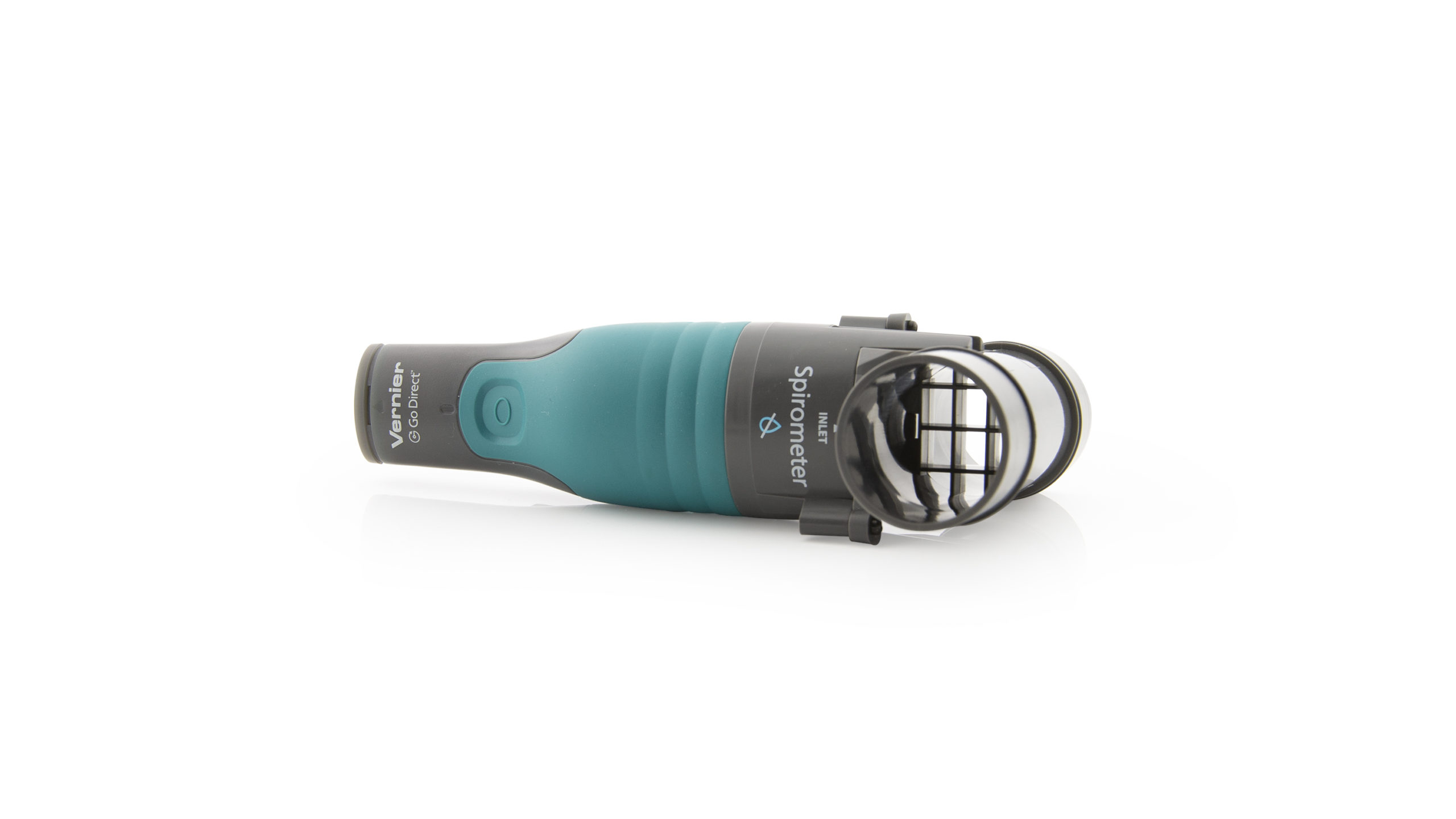Troubleshooting
General: Press the power button on the sensor to turn it on. Connect your sensor as described in the Getting Started instructions for your device.
- Primary Test
- Connect a bacterial filter and a mouthpiece to the side of the sensor marked “Inlet.”
- Hold the spirometer upright and still.
- Click or tap “Collect” to start data collection.
- Collect data for inhalation and exhalation. Confirm that the flow rate and lung volumes are reasonable. Tidal volumes will vary between 0.5 and 1.0 L.
Additional Troubleshooting
- Do you sell mouthpieces for the Spirometer that are reusable or autoclavable?
- Do I need to use a bacterial filter with the spirometer, and how many times can I use the same filter?
- Does the bacterial filter used with Vernier spirometers filter out viruses?
- How effective is the bacterial filter for the spirometer?
- Why are my tidal volumes higher than expected?
- Can I perform a custom calibration of a Vernier spirometer?
- The volume measurements from my spirometer drift up or down. How do I correct for this to calculate lung volume parameters?
- What are the dimensions of the disposable mouthpiece for the Spirometer?
- Go Direct sensor does not connect to LabQuest 2 via Bluetooth.
- How do I remove or replace a Go Direct battery?
- Troubleshooting Bluetooth Connections with Go Direct Sensors
- What can I do if a Go Direct sensor's Bluetooth LED flashes red and green when I try to connect to it and the connection fails?
- Will my device work with Go Direct Sensors via Bluetooth?
- How do I know if my LabQuest will work with Go Direct Sensors and Go Wireless devices?
Specifications
- Flow rate range: ±10 L/s
- Flow head
⚬ Volume: 41 mL
⚬ Dimensions: 29.5 mm (diameter) × 82 mm (length)
⚬ Mass: 69 g
⚬ Construction: ABS plastic - Pressure Sensor Specifications
⚬ Type: Differential
⚬ Range: ±500 Pa
⚬ Accuracy: ±1 Pa or 3% of reading
⚬ Resolution: 0.02 Pa - Operating Ranges
⚬ Normal Temperature Range: 20 to 40ºC
⚬ Humidity Range: 5–95% (non-condensing) - Calculations
⚬ Adjusted Volume: Returns volume to zero after each ventilation cycle
⚬ Cycle Volume: Reports the peak volume for each ventilation cycle
⚬ Respiration Rate
▸Sample Window: 30 s
▸Advance Window: 10 s - Connections:
⚬ Wireless: Bluetooth® v4.2 (wireless range 30 m unobstructed)
⚬ Wired: USB 2.0 full speed - Battery: 650 mAh Li-Poly
⚬ Battery Life (single, full charge): ~24 hours continuous data collection
⚬ Battery Life (lifetime): 2 – 5 years (typical)
Calibration
Calibrate? No. The Go Direct Spirometer is factory calibrated and should not require calibration by the user. For the most accurate volume measurements, we recommend adjusting the volume channel using a 2 L calibration syringe (not included). For more information, see Can I perform a custom calibration of a Vernier spirometer?
Battery Troubleshooting
- If the sensor won’t turn when on its own, but does when connected to a USB power source, try charging the sensor for at least 2 hours using a known-to-work USB cable.
- If you continue to have trouble, try swapping the battery with a working sensor to see if the problem follows the battery or stays with the sensor.
⚬ If the problem stays with the sensor, the battery is probably not the issue.
⚬ If the problem follows the battery, the battery has likely reached its end of life. - If the battery is indeed at the end of its life, the battery should be replaced.
Go Direct® 650 mAh Replacement Battery (GDX-BAT-650 ) - See How do I remove or replace a Go Direct battery? for more information (including a video).
Rechargeable batteries are covered by a one-year warranty.
Batteries should last two to five years in typical use.
Related Products
- Micro USB to USB-C Cable (
CB-USB-C-MICRO ) - Go Direct® Charge Station (
GDX-CRG ) - Disposable Bacterial Filters for Spirometer
⚬ 10 pack: SPR-FIL10
⚬ 30 pack: SPR-FIL30
⚬ 50 pack: SPR-FIL50 - Disposable Mouthpieces for Spirometer
⚬ 30 pack: SPR-MP30
⚬ 100 pack: SPR-MP100 - Noseclips for Spirometer
⚬ 10 pack: SPR-NOSE10
⚬ 30 pack: SPR-NOSE30 - O2 Gas Sensor to Spirometer Adapter (
O2-SPR ) - Spirometer (
SPR-BTA )
Replacement Parts
- Go Direct® 650 mAh Replacement Battery (
GDX-BAT-650 ) - Micro USB Cable (
CB-USB-MICRO )

